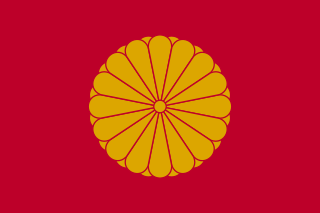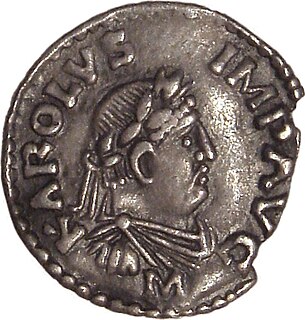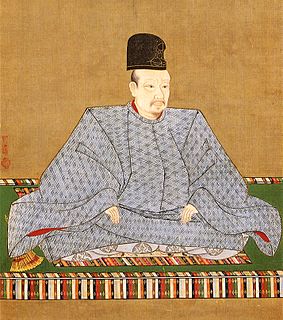
The Emperor of Japan is the head of state and the head of the Imperial Family of Japan. Under the Constitution of Japan, he is defined as "the Symbol of the State and of the Unity of the People" and his title is derived from "the Will of the People, who are the Sovereign". Imperial Household Law governs the line of imperial succession. The Supreme Court does not have judicial power over him. He is also the Head of the Shinto religion. In Japanese, the Emperor is called Tennō, literally "emperor of God". The Japanese Shinto religion holds him to be the direct descendant of the sun goddess Amaterasu. The Emperor is also the head of all national Japanese orders, decorations, medals, and awards. In English, the use of the term Mikado (帝/御門) for the emperor was once common but is now considered obsolete.

Hirohito was the 124th emperor of Japan according to the traditional order of succession, ruling over the Empire of Japan from 25 December 1926 until 2 May 1947, after which he was Emperor of the state of Japan until his death. He was succeeded by his fifth child and eldest son, Akihito. Hirohito and his wife, Empress Kōjun, had seven children, two sons and five daughters. In Japan, reigning emperors are known only as "the Emperor." He is now referred to primarily by his posthumous name, Shōwa (昭和), which is the name of the era coinciding with his reign; for this reason, he is also known as the Shōwa Emperor or Emperor Shōwa. By 1979, Hirohito was the only monarch in the world with the title "emperor." Hirohito was the longest-lived and longest-reigning historical Japanese emperor and one of the longest-reigning monarchs in the world.

The Holy Roman Empire was a multi-ethnic complex of territories in Western and Central Europe that developed during the Early Middle Ages and continued until its dissolution in 1806 during the Napoleonic Wars. The largest territory of the empire after 962 was the Kingdom of Germany, though it also included the neighboring Kingdom of Bohemia and Kingdom of Italy, plus numerous other territories, and soon after the Kingdom of Burgundy was added. However, while by the end of the 15th century the Empire was still in theory composed of three major blocks – Italy, Germany, and Burgundy – in practice only the Kingdom of Germany remained, with the Burgundian territories lost to France and the Italian territories, ignored in the Imperial Reform, although formally part of the Empire, splintered into numerous de facto independent territorial entities. The external borders of the Empire did not change noticeably from the Peace of Westphalia – which acknowledged the exclusion of Switzerland and the Northern Netherlands, and the French protectorate over Alsace – to the dissolution of the Empire. By then, it largely contained only German-speaking territories, plus the Kingdom of Bohemia, the southern Netherlands and lands of Carniola. At the conclusion of the Napoleonic Wars in 1815, most of the Holy Roman Empire was included in the German Confederation.

The Holy Roman Emperor, originally and officially the Emperor of the Romans during the middle ages, and also known as the German-Roman Emperor since the early modern period, was the ruler and head of state of the Holy Roman Empire. The Empire was considered by the Roman Catholic Church to be the only legal successor of the Roman Empire during the Middle Ages and the early modern period. The title was held in conjunction with the title of King of Italy from the 8th to the 16th century, and, almost without interruption, with the title of King of Germany throughout the 12th to 18th centuries.

Minamoto (源) was one of the surnames bestowed by the Emperors of Japan upon members of the imperial family who were excluded from the line of succession and demoted into the ranks of the nobility from 1192 to 1333. The practice was most prevalent during the Heian period, although its last occurrence was during the Sengoku period. The Taira were another such offshoot of the imperial dynasty, making both clans distant relatives. The Minamoto clan is also called the Genji (源氏), or less frequently, the Genke (源家), using the on'yomi reading for Minamoto.

Emperor Go-Yōzei was the 107th Emperor of Japan, according to the traditional order of succession. Go-Yōzei's reign spanned the years 1586 through to his abdication in 1611, corresponding to the transition between the Azuchi–Momoyama period and the Edo period.

Emperor Taizong of Tang, previously Prince of Qin, personal name Li Shimin, was the second emperor of the Tang dynasty of China, ruling from 626 to 649. He is traditionally regarded as a co-founder of the dynasty for his role in encouraging Li Yuan, his father, to rebel against the Sui dynasty at Jinyang in 617. Taizong subsequently played a pivotal role in defeating several of the dynasty's most dangerous opponents and solidifying its rule over China.

The Kangxi Emperor, personal name Xuanye, was the third Emperor of the Qing dynasty, and the second Qing emperor to rule over China proper.

Empress Dowager Cixi was a Chinese empress dowager and regent who was the de facto supreme ruler of China in the late Qing dynasty for 47 years, from 1861 until her death in 1908. Of the Manchu Yehe Nara clan, she was elected as a concubine of the Xianfeng Emperor in her adolescence and gave birth to a son, Zaichun, in 1856. After the Xianfeng Emperor's death in 1861, the young boy became the Tongzhi Emperor, and she became the Empress Dowager. Cixi ousted a group of regents appointed by the late emperor and assumed regency, which she shared with Empress Dowager Ci'an. Cixi then consolidated control over the dynasty when she installed her nephew as the Guangxu Emperor at the death of the Tongzhi Emperor in 1875, contrary to the traditional rules of succession of the Qing dynasty that had ruled China since 1644.

Naruhito is the emperor of Japan. He acceded to the Chrysanthemum Throne on 1 May 2019, beginning the Reiwa era, following the abdication of his father, Akihito. He is the 126th monarch according to Japan's traditional order of succession.

Emperor Wu of Han, formally enshrined as Emperor Wu the Filial, born Liu Che (劉徹) and courtesy name Tong (通), was the seventh emperor of the Han dynasty of ancient China, ruling from 141 to 87 BC. His reign lasted 54 years — a record not broken until the reign of the Kangxi Emperor more than 1,800 years later and remains the record for ethnic Chinese emperors. His reign resulted in a vast expansion of geopolitical influence for the Chinese civilization, and the development of a strong centralized state via governmental policies, economical reorganization and promotion of a hybrid Legalist-Confucian doctrine. In the field of historical social and cultural studies, Emperor Wu is known for his religious innovations and patronage of the poetic and musical arts, including development of the Imperial Music Bureau into a prestigious entity. It was also during his reign that cultural contact with western Eurasia was greatly increased, directly and indirectly.

Emperor Wu of Jin, personal name Sima Yan, courtesy name Anshi (安世), was the grandson of Sima Yi, nephew of Sima Shi and son of Sima Zhao. He became the first emperor of the Jin dynasty after forcing Cao Huan, last emperor of the state of Cao Wei, to abdicate to him. He reigned from 266 to 290, and after conquering the state of Eastern Wu in 280, was the emperor of a reunified China. Emperor Wu was also known for his extravagance and sensuality, especially after the unification of China; legends boasted of his incredible potency among ten thousand concubines.

The Liang dynasty (502–557), also known as the Southern Liang, was the third of the Southern Dynasties during China's Southern and Northern Dynasties period. It was located in South China and succeeded by the Chen dynasty in 557. The small rump state Western Liang (555–587), located in Central China, continued until it was destroyed in 587 by the Sui dynasty.

Aisin Gioro was the Manchu ruling clan of the Later Jin dynasty (1616–1636), the Qing dynasty (1636–1912) and, nominally, Manchukuo (1932–1945). The House of Aisin Gioro ruled China proper from 1644 until the Xinhai Revolution of 1911–1912, which established a republican government in its place. The word aisin means gold in the Manchu language, and "gioro" is the name of the Aisin Gioro's ancestral home in present-day Yilan, Heilongjiang Province. In Manchu custom, families are identified first by their hala (哈拉), i.e. their family or clan name, and then by mukūn (穆昆), the more detailed classification, typically referring to individual families. In the case of Aisin Gioro, Aisin is the mukūn, and Gioro is the hala. Other members of the Gioro clan include Irgen Gioro (伊爾根覺羅), Šušu Gioro (舒舒覺羅) and Sirin Gioro (西林覺羅).

Emperor Gaozu of Tang, born Li Yuan, courtesy name Shude, was the founder of the Tang dynasty of China, and the first emperor of this dynasty from 618 to 626. Under the Sui dynasty, Li Yuan was the governor in the area of modern-day Shanxi, and was based in Taiyuan.

Emperor Wen of Sui, personal name Yang Jian (楊堅), Xianbei name Puliuru Jian (普六茹堅), alias Narayana deriving from Buddhist terms, was the founder and first emperor of China's Sui dynasty. He was a hard-working administrator and a micromanager. The Sui Shu records him as having withdrawn his favour from the Confucians, giving it to "the group advocating Xing-Ming and authoritarian government." As a Buddhist, he encouraged the spread of Buddhism through the state. He is regarded as one of the most important emperors in ancient Chinese history, reunifying China in 589 after centuries of division since the fall of the Western Jin dynasty in 316. During his reign, the construction of the Grand Canal began.

The Imperial House of Japan, also referred to as the Imperial Family, comprises those members of the extended family of the reigning Emperor of Japan who undertake official and public duties. Under the present Constitution of Japan, the Emperor is "the symbol of the State and of the unity of the people". Other members of the Imperial Family perform ceremonial and social duties, but have no role in the affairs of government. The duties as an Emperor are passed down the line to their male children.

Emperor Meiji, also called Meiji the Great, or Meiji the Good, was the 122nd Emperor of Japan according to the traditional order of succession, reigning from 3 February 1867 until his death on 30 July 1912, and the first monarch of the Empire of Japan. He presided over the Meiji era, a time of rapid change that witnessed Japan's transformation from an isolationist, feudal state to an industrialized world power.

Akihito is a member of the Imperial House of Japan who reigned as the 125th emperor of Japan, according to the traditional order of succession, from 7 January 1989 until 30 April 2019, Heisei era. He succeeded to the Chrysanthemum Throne upon the death of his father, Emperor Showa (Hirohito). Upon his abdication due to his age and declining health, he became Emperor Emeritus. He was succeeded by his eldest son, Naruhito.

Emperor Taishō was the 123rd Emperor of Japan, according to the traditional order of succession, and the second ruler of the Empire of Japan from 30 July 1912 until his death in 1926.



















